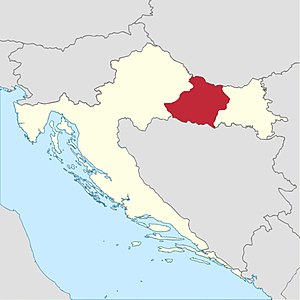Diocese of Požega
| Diocese of Požega | |
| Basic data | |
|---|---|
| Country | Croatia |
| Ecclesiastical province | Đakovo-Osijek |
| Metropolitan bishopric | Archdiocese of Đakovo-Osijek |
| Diocesan bishop | Antun Škvorčević |
| Vicar General | Josip Krpeljević |
| founding | 1997 |
| surface | 6,931 km² |
| Dean's offices | 7 (2004) |
| Parishes | 93 (2016 / AP 2017 ) |
| Residents | 278,277 (2016 / AP 2017 ) |
| Catholics | 253.058 (2016 / AP 2017 ) |
| proportion of | 90.9% |
| Diocesan priest | 100 (2016 / AP 2017 ) |
| Religious priest | 24 (2016 / AP 2017 ) |
| Catholics per priest | 2,041 |
| Permanent deacons | 2 (2016 / AP 2017 ) |
| Friars | 46 (2016 / AP 2017 ) |
| Religious sisters | 73 (2016 / AP 2017 ) |
| rite | Roman rite |
| Liturgical language | Croatian |
| cathedral | St. Teresa of Ávila |
| address | Trg Sv. Trojstva 18 34000 Požega |
| Website | pozega.hbk.hr |

The Roman Catholic Diocese of Požega ( lat. : Dioecesis Posegana , kroat. : Požeška Biskupija ) is in Croatia located diocese of the Roman Catholic Church based in Pozega .
History of the Požega Diocese
Since the first written mention of Požega in 1227, it has been the center of religious life in the area. The city was owned by the Church. This is from a confirmation letter from Pope Honorius III. evident. The Pope's letter mentions the donation of the Požega Fortress by King Andrew II to the Bishop of the Archdiocese of Zagreb Ugrin . At the same time, Pope Honorius III promises. Bishop Ugrin expressed his pastoral support in the fight against the continuing spread of the Bogomil heresy from Bosnia into the area of Slavonia .
The first record of the Požega parish dates back to the first half of the 13th century. The parish church was dedicated to St. Paul the Apostle . In the second half of the 13th century, in 1285, the Franciscans first found themselves in the city. At the beginning of the 16th century they built their church and the Franciscan monastery, which was consecrated to Saint Dimitrius (martyr). At the same time, the Dominican order built its monastery and church of the Holy Mother of God (later consecrated to St. Lawrence of Rome ).
Shortly before the Ottomans invaded the Dominicans left the city of Požega. During the Ottoman rule from 1573 to 1691, the Franciscans took care of the Catholic population to a significant extent pastorally - as the only priests present . After the final liberation from Ottoman rule in 1702, the town's parish was renewed. At the end of the 17th century the Jesuit order spreads in Slavonia . The city of Požega became the center of their work. The Jesuits made a great contribution to the education and training of the local youth. As early as 1698/1699 they founded the municipal high school . From 1761 to 1776 its theological and philosophical faculty (Academica posegana) was in the city. Nowadays the seat of the diocesan administration is located there. The Jesuit order also opened a pharmacy for the first time in the city.
After the temporary dissolution of the order, the Paulan Order took over the fields of activity of the Jesuits until 1786 (after its dissolution). In 1765, Empress Maria Theresa of Austria granted the city the special right of a free royal city. From 1756 to 1763 the Church of St. Teresa of Ávila was built, one of the most beautiful Baroque churches in Slavonia and the current cathedral of the Požega diocese. The Order of the Vincentine Sisters has been resident in the diocese since 1862. The main task of the order is education and upbringing.
On September 27, 1997, Pope John Paul II established the diocese Požega with the Apostolic Constitution Praeclarum evangelizationis . On June 18, 2008, the diocese of Pope Benedict XVI. assigned to the Archdiocese of Đakovo-Osijek as a suffragan diocese .
structure
The diocese is divided into seven deaneries :
- Našice (11 parishes)
- Nova Gradiška (12 parishes)
- Nova Kapela (12 parishes)
- Pakrac (13 parishes)
- Požega (18 parishes)
- Virovitica (12 parishes)
- Novlja (7 parishes).
literature
- The wounded church in Croatia. The destruction of the sacred building heritage of Croatia 1991–1995 , ed. vd Croatian Bishops' Conference u. a., Zagreb 1996, ISBN 953-6525-02-X

